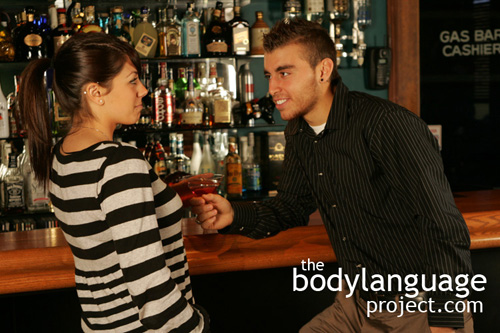“Fences make great neighbours” seems like a great truism for our day and we see just as many fences going up as we do houses. Humans are very social, but it is also obvious that we are deeply territorial. While in public, a wife might display ownership of her husband by hooking her arm around his, or he might throw an arm around her just the same. We show that an automobile that we are proud of is ours by leaning up against it or placing a foot on its bumper or ownership of a desk by tossing our feet up on top of it. We display ownership of our houses and personal affair by adding personal touches and might even block the entry to our homes by solicitors through clogging the doorway with our bodies.
Territorial lines are drawn everywhere in our lives from the particularities of our offices and automobiles, right down to the rooms in our own homes, and whom has access to them. We even have boundaries around our bodies which we protect rigorously. The more dominant the individual, the more apt they are to have and hold rigid boundaries about their personal space and possessions. For example, walking into your boss’s office and sitting in his chair won’t come with a welcome reception. But amongst friends, this type of chair stealing happens frequently and can even become a game, due largely to the fact that you and your friends are of equal status. It wouldn’t be uncommon for the boss’s children to play this game with their dad, so in some context, stealing territory is perfectly tolerable with all people.
Only sometimes does first come – first serve, apply to territories. Squatter’s rights as it where is also organized by hierarchy. Those with higher rank can often force others to move, even just by their presence. Sitting at the head of a table is fine so long as you are the highest rank to date, but if someone of higher rank appears, it’s customary to relinquish, or at least offer the seat to them. Members of a staff who are close in rank can sometimes power play each other for these seats at the boardroom table in attempt to move up. The body language in these situations can become very potent as the desires of each party becomes more evident. Your office staff knows which seats are most coveted!
Leaders also get permission to move through doorways first and walk in front of groups instead of follow, and it is customary to allow them to do so. The exception, as always, comes when we wish to usurp their position, challenge their authority, or try to build equality where we might trade dominance rights back and forth.
Placing objects such as jackets and brief cases on a seat can hold it and delineate temporary ownership. It is often easier and more polite to force an actual person to move than to move their unattended personal items to usurp their space. Anyone who has spent anytime at a laundry mat knows how piercing the stares and looks can be when you remove clothing from an un-attended dryer. Break-and-enter-victims complain most, not about being robbed of their possessions, but rather about feeling of violation. It is unnerving to have had someone enter their personal space and hence territory without their permission. Territoriality is a big part of the human repertoire. We rarely think about ownership of people, but placing an arm over someone, playfully messing up their hair or guiding them to where we want them to go by placing a hand to their back, as a parent would his child, are just a few ways that we show others that we own and control them.
Bragging is an appropriate word that describes dominant behaviour in the same context with ownership. Dominance is also not the same as confidence. Dominance just means that someone has specific ideas about how they should be treated whereas confidence is a state of mind where a person remains unshaken emotionally despite what happens externally. Therefore, dominant people can still harbour insecurities about themselves which is evident through ownership because they will spend a lot of time talking about, or drawing attention to their stuff. Naturally, this sort of thing happens subconsciously, or even out of habit. Touching or fondling an expensive watch or piece of jewelry, or going out of their way to be seen in an expensive car are just two examples of flaunting. Truly confident people have no need to show-off to others, their achievements are grand enough to speak for themselves and their earned success emanates from them through their nonverbal behaviour. There’s a fine line between being cocky or arrogant and having to flaunt it in a way that others will find offensive, and being confident, which is exuded seemingly naturally of which people find magnetic. Confidence is one of those things that we all know it when we see it. Dominance that is justified by accomplishments is certainly more tolerable, and with the addition of compassion and empathy, can make all the difference in people’s acceptance of other’s dominance and the behaviour that follows.
Dominance is also expressed through claiming stake to valuable items, or the prevention of touching certain things, or even occupying certain space. Preventing others from doing things, even at random is a luxury afforded to, and by, powerful people. Even when seating is unassigned we often see the same people day-after-day sitting in the same seats. This may have to do with maintain peace when it happens on a first come first served basis, but when there is a shortage of quality positions, as there most often is, we expect to see more dominant players jockey for more highly desirable areas. This is exactly what does happen and because we live in a capitalist society, it happens everywhere and often. Those higher in the ranks will have the best parking spots and the biggest offices, with the best view.
Thwarting dominance by ownership is fairly simple but also a possibly caustic affair. It can be done by stealing a seat which will be seen as an invasion of territory, it could include getting into their personal space, leaning on their cars, putting feet on their furniture or desk or being overly-friendly with them. Being intimate with someone they are close to, such as a current or past romantic partner, or as in a father-daughter relationship, his daughter, are all ways to fight dominance head on! Obviously, you must be careful what you choose, as head-to-head dominance struggles are the beginnings of war! When there is an imbalance of power between dominant people, one party will quickly succeed to the other, but when two parties are evenly match, or believe that they are, the struggle can draw out indefinitely producing emotional of even physical injury. So instead of antagonizing your dominant counterparts, instead work on building your own dominance independently of their through confident body language, examples of which are peppered throughout this book!






